Finding Friendship In The City Of Hyenas
In a place that welcomes hyenas after dark, an anthropologist ends up bonding with one of the fiercest predators on earth.
By Vicki Croke
Hyenas aren’t the most popular animals. In Western literature, they are depicted as giggling, cowardly, and dangerous. In almost all of Africa, where the formidable predators are known to bite people’s faces off, kill children, crunch bone like it’s popcorn, and disembowel antelope, they are downright loathed.
But there’s at least one place on the continent where hyenas are not only tolerated they are welcomed. It’s Harar, Ethiopia. Here, long ago, the inhabitants carved doorways into the 500-year-old stone wall that surrounds the old section of the city, to invite a nightly migration of wild hyenas that continues to this day.

A crowded and holy place, Harar, Ethiopia, has developed a culture that is pro-hyena. Video still courtesy of Marcus Baynes-Rock.
Padding in under cover of darkness, when most locals are asleep, spotted hyenas in groups, pairs, or on their own, enter through the waraba nudul or “hyena holes,” trotting across cobblestones, and gliding down sidewalks. To the people here, it’s part of life. A good part. One in which both humans and hyenas benefit, and one in which both species tend to play by an unwritten rule of etiquette—look but don’t touch.

A “waraba nudul” or “hyena hole” in the town wall welcomes hyenas after dark. Photo: Marcus Baynes-Rock.
The hyenas come in for handouts of meat scraps, which can draw paying tourists to the men who feed them. They pick through garbage at the dump, which helps keep the city tidy. And, it is said, these nocturnal creatures provide another, more spectral cleaning service—they are believed to devour the malingering bad spirits of dead people.
It’s easy to see why an anthropologist might want to investigate. That’s exactly what Marcus Baynes-Rock, author of the new book “Among the Bone Eaters” did in 2009. And he ended up gaining more than a dissertation. He actually became an irregular part of the human-hyena culture—running through the darkened streets with the big predators. Playing tag with them. And changing from an academic into someone who, as they say in Harar, has “the blood of the hyena.”
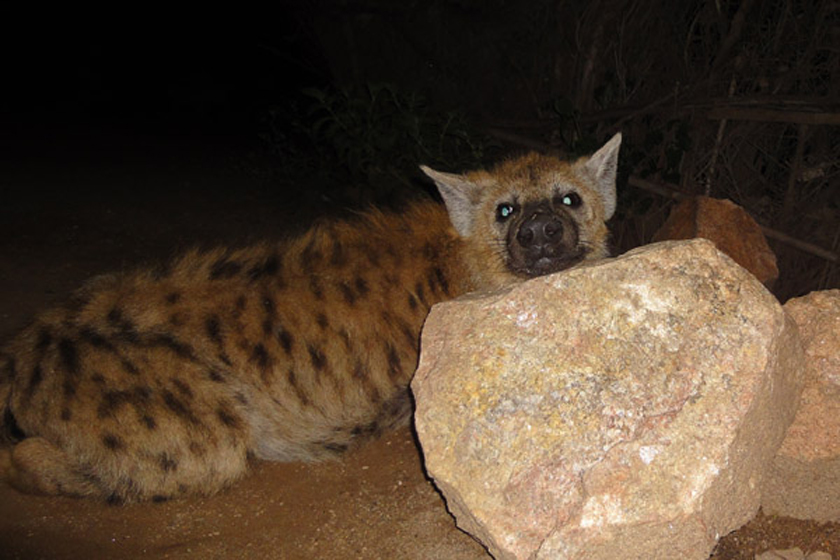
Willi was almost like the old movie and TV depictions of Lassie the dog: He made clear overtures to Baynes-Rock to join him, and the two formed a bond. Photo: Marcus Baynes-Rock.
It all started with one young rule-breaking hyena named Willi. He was only seven months old, sandy colored, spotted, and pointy-nosed.
“His facial expression was always kind of worried…he looked like the kid who always expected something bad was going to happen to him,” Baynes-Rock tells me by phone from Australia.
Baynes-Rock met Willi at the home of Yusuf, one of the city’s so called hyena-feeders. The anthropologist had been conducting much of his research by observing Yusuf—who, every night offered Baby, Kamareya, Willi and a slew of other hyenas meat from kabob-like sticks—which he sometimes held between clenched teeth. It was often a chaotic scene.
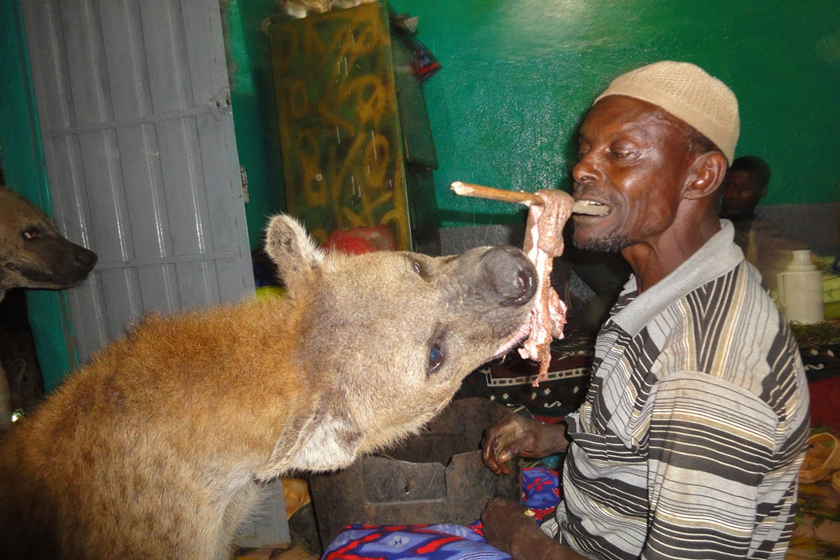
A big, powerful hyena eats a meat offering from Yusuf. Marcus writes: “‘Seeing Yusuf face to face with the hyenas like that made me realize how large their heads were. Actually, ‘huge’ would be a more appropriate adjective. Their broad teeth flashed white from behind dark lips, their massive jaw muscles bulging beneath their cheeks.” Photo: Marcus Baynes-Rock.
Here, as with at least one other such feeding station, things follow a predictable pattern: The tourists arrive, and the men who feed hyenas, Baynes-Rock says, “take out buckets of meat scraps and they start giving food to the hyenas, the people take photographs, taxis turn up and put their headlights on the hyenas. It can be pretty involved. You can get a lot of hyenas at one of these feeding places.”
It was against that backdrop that Willi appeared. The young hyena first broke the ice by play chomping Baynes-Rock’s knee, which is a pretty scary thing from a creature who is thought to have one of the strongest bites in the animal kingdom.

Hyenas may look like dogs, but they are more closely related to cats than dogs. Photo: Marcus Baynes-Rock.
The anthropologist recorded this interaction in his field notes (and reprinted it in the online journal “Between the Species”):
“I went around the front of Yusuf’s house and found Willi lying down. So I sat on the rock pile and spoke to him. To my surprise, he came over and began sniffing me. I stayed still. He sniffed my flashlight, my hands, and my knees. I tried to pat him but he shied away from my hand. Then while he was sniffing my knee, he opened his mouth and was about to take a bite, using the side of his mouth, the way a hyena eats a bone. I pulled my knee away and reprimanded him, telling him I wasn’t food. He went and sat and washed himself.” (Field notes, March 2010).
But their relationship evolved. And soon Baynes-Rock saw that Willi was treating him like he was just another hyena. A playmate. So he allowed the physical interaction.
At Willi’s invitation, Baynes-Rock started running with the hyenas—through the alleyways, to the garbage dump, and even to their sacred place—their den.
Marcus gets some one-on-one time with a hyena. A description of an interaction with Willi, from the book: “I could see that he was going to be gentle, so I let him have at it. He felt his way with his teeth along my jacket sleeve, and then, when he managed to get sleeve and no arm between his teeth, he bit and pulled. At the same time, I grabbed a handful of the skin on his back and pulled at that. We wrestled like that for some time…” Video: hararhyenas/YouTube.
He spent so much time with the hyenas that he even got fleas.
More than that, with the hyenas, he found an exhilarating sense of belonging. “As we played—as we took on the roles of chaser and chased—the boundaries between us became permeable,” Baynes-Rock writes in “Among the Bone Eaters.” Scampering around with Willi and two other hyenas named Baby and Kamareya, he was struck by “how strange and yet how perfectly normal it was to be standing next to a hyena, staring into the forest. Suddenly, there was no species boundary between Baby and me; we were playmates and co-hunters of whatever it was Kamareya was being…”
The anthropologist even fended off neighborhood dogs who were fearful of humans, but aggressive toward the hyenas. And from this he derived a keen sense of “comradeship.”
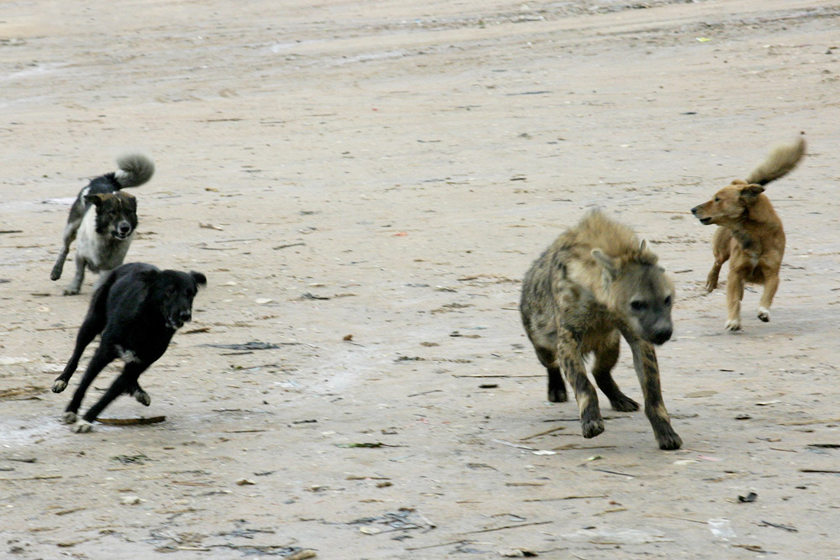
Neighborhood dogs harassed hyenas, but if Baynes-Rock were around, he’d fend them off. Photo: Marcus Baynes-Rock.
“Anyone who has a dog or a cat knows that they’re a person,” Baynes-Rock says. “And hyenas are just as much people as dogs and cats.”
He had a different relationship with the hyenas than the city residents did. But his research revealed the remarkable degree to which hyenas are viewed positively. In a survey he conducted, he found that the majority of residents had a positive attitude toward the nocturnal visitors.
For one thing, most people never see the animals. “In the streets, there are not that many interactions,” Baynes-Rock explains, “because the hyenas go in there late at night. Usually, if they hear people coming, they’ll find a hiding place or just turn and run in the opposite direction.” And for another, the hyenas are terrific environmentalists. They clean up bones and scraps from dumps and drainage ditches.
Naime, Yusuf’s wife, feeds the hyenas. Video: hararhyenas/YouTube.
But there is another aspect that fascinated the anthropologist.
“It’s essentially that hyenas can see, hear, catch, and eat harmful spirits,” Baynes-Rock says. “I can only speculate but it probably goes back to a pre-Christian, pre-Islamic belief system because it’s so widespread. In the East, these harmful spirits are known as jinn, which is a typical Islamic conception. So, among the Muslim population in the East, they’re adamant that hyenas can see and catch jinn…and they’re pretty handy to have around because they control jinn.”
Also on The Wild Life:
Spotted Hyenas: Gender Bending, Enchanting, Formidable
Two things seem to bolster this belief: one, when hyenas whoop, they put their nose to the ground, which could appear to be “sucking an unseen spirit from the ground.” And two, though hyenas can chew and digest just about everything, they occasionally do vomit. And the slimy “gag-balls” they produce often contain fur and shards of bone that look an awful lot like the hair and fingernails of a human…or a human-like evil spirit.
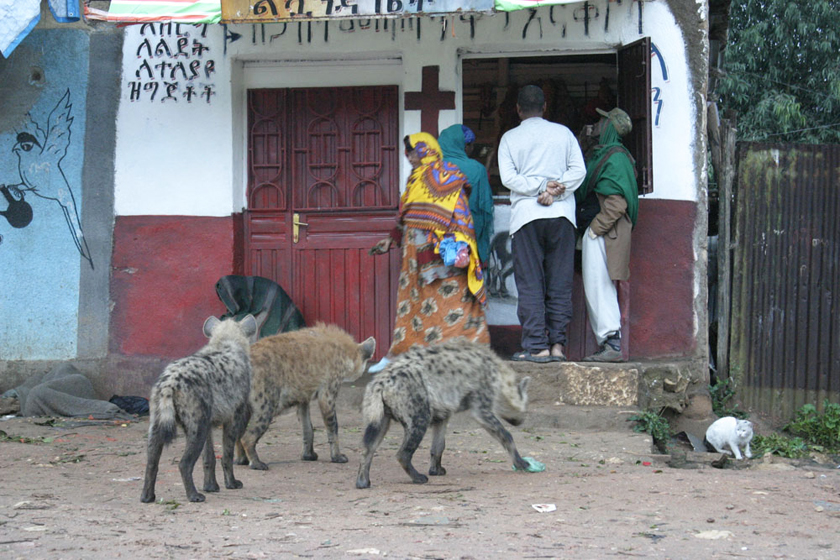
People and hyenas gather outside a butcher shop in Harar. (We wonder what the cat is thinking.) Photo: Marcus Baynes-Rock.
Baynes-Rock knew of cases in which psychologically unbalanced people were brought to the hyenas in hopes of some kind of exorcism.
The anthropologist may not have felt in need of any spiritual tune-up himself, and yet, he found that the animals did influence his outlook on life. “Some of their world-view just rubs off on you,” he says.
They gave him a sense of humility, he says, some pragmatism, and he admires the way they actually avoid conflict. But he worried that they heightened his own natural wariness of his fellow humans.
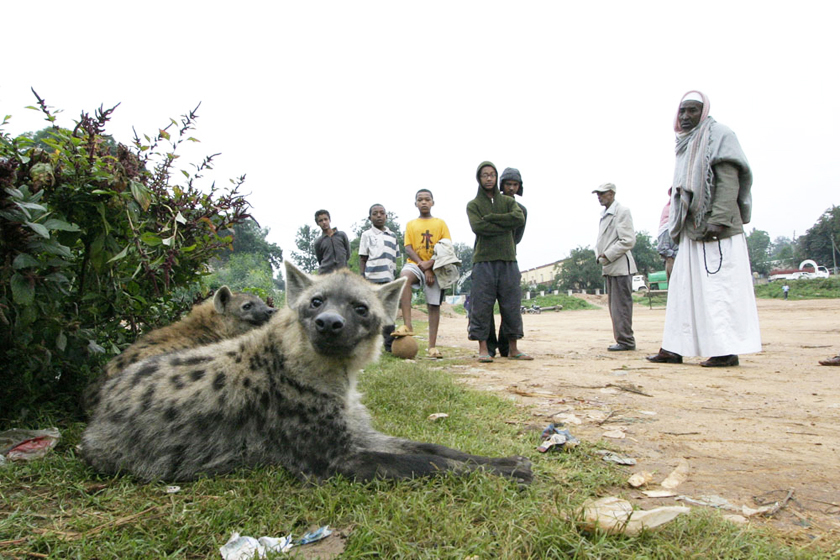
For the most part, hyenas and people in Harar do not touch each other. The vast majority of people here see hyenas in a positive way, and few report any unpleasant contact with them. Photo: Marcus Baynes-Rock.
Once, while running with them, he recoiled from what he thought was an intruding man. “It actually startled me—I had a hyena-like reaction…but that’s when it occurred to me—hey, I’m beginning to see people the same way these guys do…” Baynes-Rock says.
Things didn’t go too far for the hyena man. Baynes-Rock did come back around to rejoin the human world—he met and married a woman in Harar, and moved home to Australia. But, there’ll always be some part of him running with that wild clan. You can hear it in the whooping ringtone on his phone, you can read it in his blog about hyenas, and you can sense it in the way he gives out compliments. After all, one of the ways he praises his wife is by noting the “hyenalikeness” in her.
Baynes-Rock would love it if his book did a little something to alter the worldwide perception of hyenas. “People really despise hyenas,” he says, and he doesn’t think that’s going to change.
It’s too bad. Field biologists have shown that hyenas are magnificent animals, devoted mothers, full of personality, and that they are brave hunters.
But for a moment, Baynes-Rock enjoys the idea that the reputation of the hyena might be rehabilitated by his stories: “I’d love for people to change their minds and think that hyenas are the best animals in the world and they’re so cute and better than tigers and pandas!”

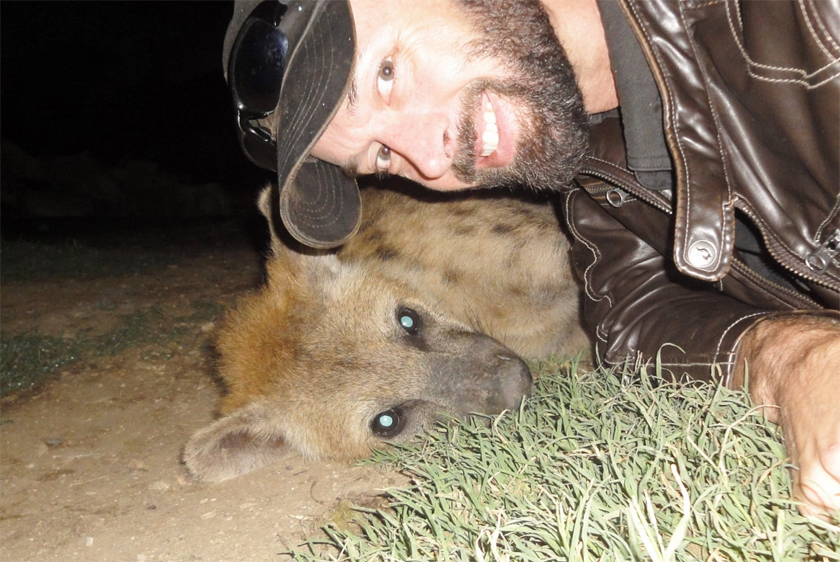

One Response to “Finding Friendship In The City Of Hyenas”
This is amazing story about wild life. These animals are wonderful at the same time fearful the way they behave. This is also a good chance for scientist to closely study these creatures for the benefit of conservation on earth. I am not sure I can comfortably stand along side one but it appears like a daily routine of the people who live in that part of the world.
We have K-9 and it could be a good thing to try to domesticate these creatures and see what role they may have in our changing society.
Comments are closed.